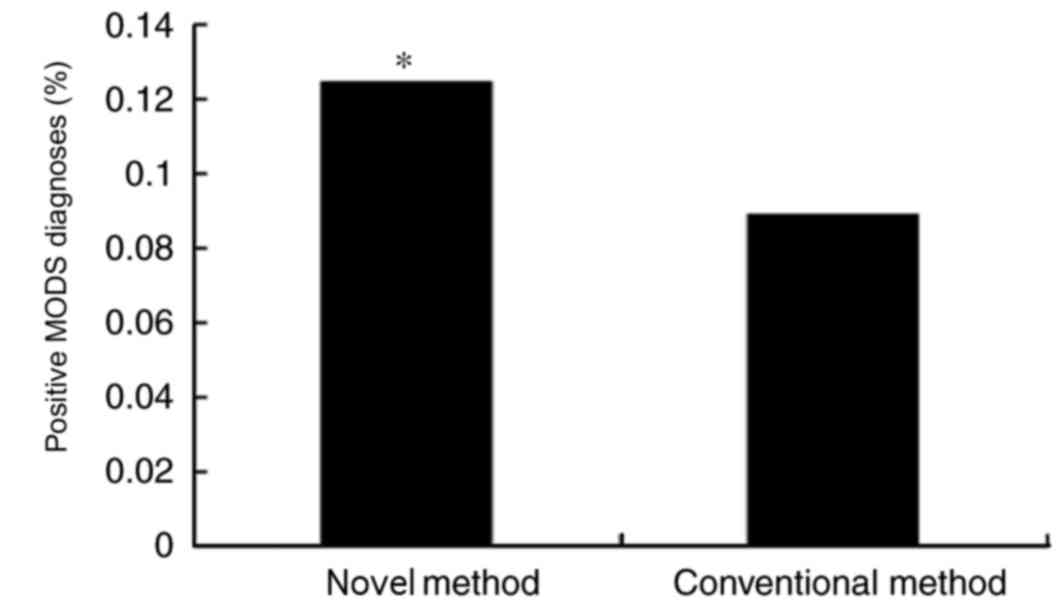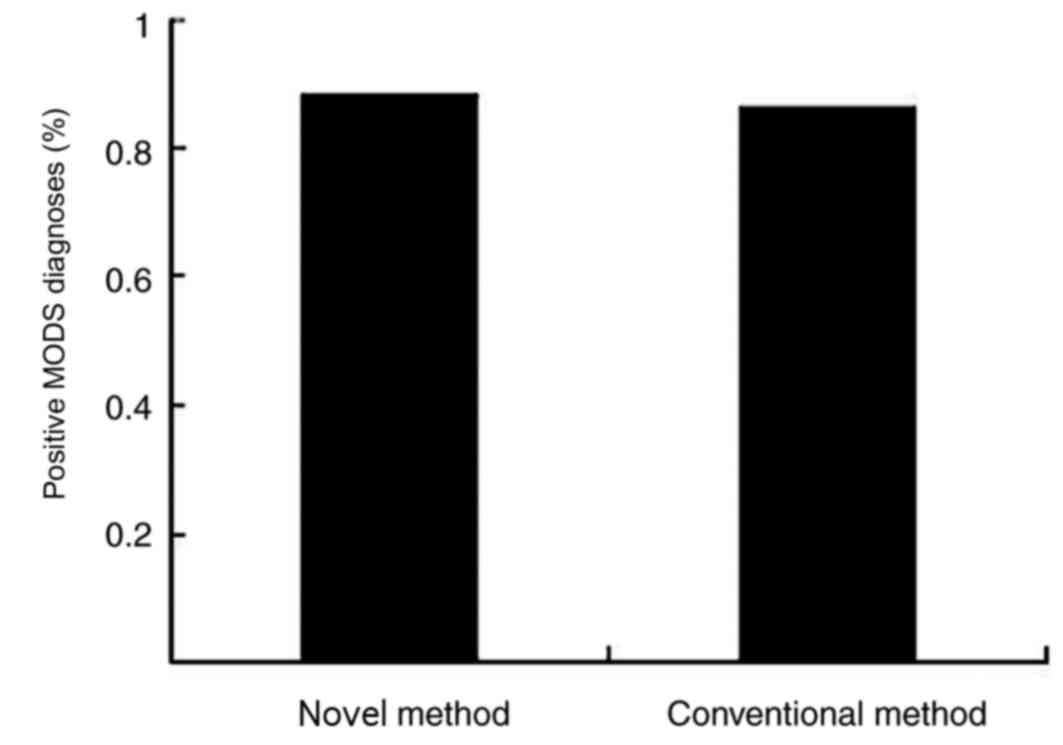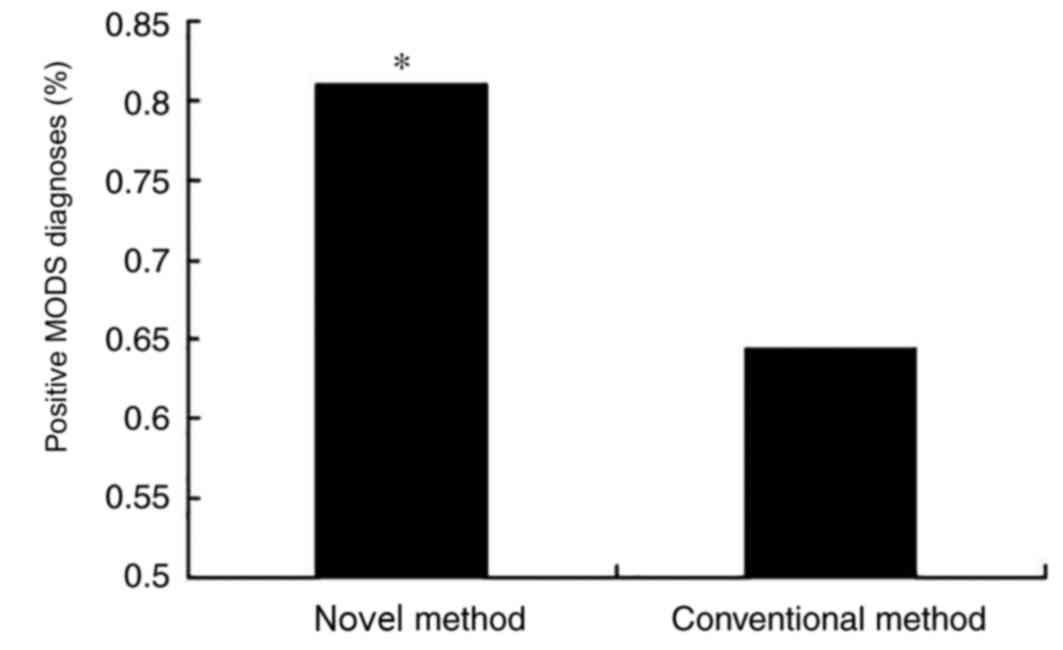|
1
|
Guillaume A, Pili-Floury S, Chocron S,
Delabrousse E, De Parseval B, Koch S, Samain E, Capellier G and
Piton G: Acute mesenteric ischemia among postcardiac surgery
patients presenting with multiple organ failure. Shock. 47:296–302.
2017. View Article : Google Scholar : PubMed/NCBI
|
|
2
|
Rosenthal MD and Moore FA: Persistent
inflammatory, immunosuppressed, catabolic syndrome (PICS): A new
phenotype of multiple organ failure. J Adv Nutr Hum Metab. 26:pii:
e784. 2015.
|
|
3
|
Wang C, Su Q, Zhang SW, Yin CH, Wang H and
Wang BE: A clinical study on the diagnostic criteria of multiple
organ dysfunction syndrome. Zhonghua Wai Ke Za Zhi. 47:40–43.
2009.(In Chinese). PubMed/NCBI
|
|
4
|
Zhang SW, Wang C, Yin CH, Wang H and Wang
BE: Multi-center clinical study on the diagnostic criteria for
multiple organ dysfunction syndrome with illness severity score
system. Zhongguo Wei Zhong Bing Ji Jiu Yi Xue. 16:328–332. 2004.(In
Chinese). PubMed/NCBI
|
|
5
|
Fröhlich M, Wafaisade A, Mansuri A, Koenen
P, Probst C, Maegele M, Bouillon B and Sakka SG: Which score should
be used for posttraumatic multiple organ failure?-Comparison of the
MODS, Denver- and SOFA-Scores. Scand J Trauma Resusc Emerg Med.
24:1302016. View Article : Google Scholar : PubMed/NCBI
|
|
6
|
Hutchings L, Watkinson P, Young JD and
Willett K: Defining multiple organ failure after major trauma: A
comparison of the denver, sequential organ failure assessment, and
Marshall scoring systems. J Trauma Acute Care Surg. 82:534–541.
2017. View Article : Google Scholar : PubMed/NCBI
|
|
7
|
Muthaiah B, Thippeswamy T, Kondareddy S
and Chikkegowda P: Study of aetiology and outcome in acute Febrile
illness patients with multiple organ dysfunction syndrome. J Clin
Diagn Res. 10:OC16–OC18. 2016.PubMed/NCBI
|
|
8
|
Aarvold AB, Ryan HM, Magee LA, von
Dadelszen P, Fjell C and Walley KR: Multiple organ dysfunction
score is superior to the obstetric-specific sepsis in obstetrics
score in predicting mortality in septic obstetric patients. Crit
Care Med. 45:e49–e57. 2017. View Article : Google Scholar : PubMed/NCBI
|
|
9
|
Zhao PF, Fu XM, Wang C and Wang H:
Multiple organ dysfunction syndrome diagnostic criteria and scoring
system for the status quo. J Clin Exp Med. 12:630–636. 2013.
|
|
10
|
Wang C, Su Q, Zhang SW, Yin CH, Wang H and
Wang BE: Scoring system to measure the severity of the multiple
organ dysfunction syndrome. Zhongguo Yi Xue Ke Xue Yuan Xue Bao.
29:497–500. 2007.(In Chinese). PubMed/NCBI
|
|
11
|
Zhang YL: Multiple organ dysfunction
syndrome. J Trauma Surg. 3:75–77. 2001.(In Chinese).
|
|
12
|
Burke SJ, Stadler K, Lu D, Gleason E, Han
A, Donohoe DR, Rogers RC, Hermann GE, Karlstad MD and Collier JJ:
IL-1β reciprocally regulates chemokine and insulin secretion in
pancreatic β-cells via NF-κB. Am J Physiol Endocrinol Metab.
309:E715–E726. 2015. View Article : Google Scholar : PubMed/NCBI
|
|
13
|
Fatima N, Faisal SM, Zubair S, Ajmal M,
Siddiqui SS, Moin S and Owais M: Role of pro-inflammatory cytokines
and biochemical markers in the pathogenesis of Type 1 diabetes:
Correlation with age and glycemic condition in diabetic human
subjects. PLoS One. 11:01615482016. View Article : Google Scholar
|
|
14
|
Donath MY, Størling J, Maedler K and
Mandrup-Poulsen T: Inflammatory mediators and islet beta-cell
failure: A link between type 1 and type 2diabetes. J Mol Med.
81:455–470. 2003. View Article : Google Scholar : PubMed/NCBI
|
|
15
|
Wang F, Yin J, Ma Y, Jiang H and Li Y:
Vitexin alleviates lipopolysaccharide-induced islet cell injury by
inhibiting HMGB1 release. Mol Med Rep. 15:1079–1086. 2017.
View Article : Google Scholar : PubMed/NCBI
|
|
16
|
Kyle UG, Coss Bu JA, Kennedy CE and
Jefferson LS: Organ dysfunction is associated with hyperglycemia in
critically ill children. Intensive Care Med. 36:312–320. 2010.
View Article : Google Scholar : PubMed/NCBI
|
|
17
|
Jeschke MG, Pinto R, Herndon DN, Finnerty
CC and Kraft R: Hypoglycemia is associated with increased postburn
morbidity and mortality in pediatricpatients. Crit Care Med.
42:1221–1231. 2014. View Article : Google Scholar : PubMed/NCBI
|
|
18
|
Branco RG, Chavan A and Tasker RC: Pilot
evaluation of continuous subcutaneous glucose monitoring in
children withmultiple organ dysfunction syndrome. Pediatr Crit Care
Med. 11:415–419. 2010.PubMed/NCBI
|
|
19
|
Marti JL and Leitman IM: Understanding the
causes of hyperglycemia in burn patients. J Surg Res. 182:205–206.
2013. View Article : Google Scholar : PubMed/NCBI
|
|
20
|
Bosarge PL, Shoultz TH, Griffin RL and
Kerby JD: Stress-induced hyperglycemia is associated with higher
mortality in severe traumatic brain injury. J Trauma Acute Care
Surg. 79:289–294. 2015. View Article : Google Scholar : PubMed/NCBI
|
|
21
|
Lei W, Wang Z and Liu L: Study on the
disfunction of Pancreatic β and insulin resistance caused by severe
brain injure. Chin J neurosurgery Dis Res. 6:414–418. 2007.
|
|
22
|
Matthews DR, Hosker JP, Rudenski AS,
Naylor BA, Treacher DF and Turner RC: Homeostasis model assessment:
Insulin resistance and beta-cell function from fasting plasma
glucose and insulin concentrations in man. Diabetologia.
28:412–419. 1985. View Article : Google Scholar : PubMed/NCBI
|
|
23
|
Pratley RE and Weyer C: The role of
impaired early insulin secretion in the pathogenesis of Type II
diabetes mellitus. Diabetologia. 44:929–945. 2001. View Article : Google Scholar : PubMed/NCBI
|
|
24
|
Siddiqui MS, Cheang KL, Luketic VA, Boyett
S, Idowu MO, Patidar K, Puri P, Matherly S, Stravitz RT, Sterling
RK and Sanyal AJ: Nonalcoholic steatohepatitis (NASH) is associated
with a decline in pancreatic beta cell (β-Cell) function. Dig Dis
Sci. 60:2529–2537. 2015. View Article : Google Scholar : PubMed/NCBI
|
|
25
|
Zhu HQ, Yang ZJ, Zhang B, Xiao JZ and Yang
WY: Ageing related changes of insulin secretion and insulin
sensitivity among normal glucose tolerance individuals in China.
Zhonghua Yi Xue Za Zhi. 92:1948–1953. 2012.(In Chinese). PubMed/NCBI
|
|
26
|
Yamauchi K, Sato Y, Nakasone Y and Aizawa
T: Comparison of HOMA-IR, HOMA-β% and disposition index between US
white men and Japanese men in Japan in the ERA JUMP study: Was the
calculation of disposition index legitimate. 58:1679–1680.
2015.
|
|
27
|
Nolan JJ and Faerch K: Estimating insulin
sensitivity and beta cell function: Perspectives from the modern
pandemics of obesity and type 2 diabetes. Diabetologia.
55:2863–2877. 2012. View Article : Google Scholar : PubMed/NCBI
|
|
28
|
Shi SQ: The progress of diagnosis and
treatment of multiple organ dysfunction syndrome. Zhong Hua Ji Zhen
Yi Xue Za Zhi. 22:824–826. 2013.(In Chinese).
|
|
29
|
Wang ZG: Traumatic surgery. Shanghai:
Shang Hai Ke Xue Ji Shu Chu Ban She 257; 2002
|
|
30
|
Marshall JC, Cook DJ, Christou NV, Bernard
GR, Sprung CL and Sibbald WJ: Multiple organ dysfunction score: A
reliable descriptor of a complex clinical outcome. Crit Care Med.
23:1638–1652. 1995. View Article : Google Scholar : PubMed/NCBI
|
|
31
|
Vincent JL, de Mendonça A, Cantraine F,
Moreno R, Takala J, Suter PM, Sprung CL, Colardyn F and Blecher S:
Use of the SOFA score to assess the incidence of organ
dysfunction/failure in intensive care units: results of a
multicenter, prospective study. Working group on ‘sepsis-related
problems’ of the European Society of Intensive Care Medicine. Crit
Care Med. 26:1793–1800. 1998. View Article : Google Scholar : PubMed/NCBI
|
|
32
|
Ramtinfar S, Chabok SY, Chari AJ,
Reihanian Z, Leili EK and Alizadeh A: Early detection of
nonneurologic organ failure in patients with severe traumatic brain
injury: Multiple organ dysfunction score or sequential organ
failure assessment. Indian. J Crit Care Med. 20:575–580. 2016.
|
|
33
|
Kaml GJ and Davis KA: Surgical critical
care for the patient with sepsis and multiple organ dysfunction.
Anesthesiol Clin. 34:681–696. 2016. View Article : Google Scholar : PubMed/NCBI
|
|
34
|
Liu XY, Jiang M, Yi CL, Bai XJ and Hak DJ:
Early intramedullary nailing for femoral fractures in patients with
severe thoracic trauma: A systemic review and meta-analysis. Chin J
Traumatol. 19:160–163. 2016. View Article : Google Scholar : PubMed/NCBI
|
|
35
|
Zhou QQ and Zhang SF: Early diagnosis and
clinical treatment for severe acute mountain sickness with multiple
organ dysfunction syndrome. Medical J Chinese People's Liberation
Army. 3510:1183–1186. 2010.
|
|
36
|
Herzberg-Schäfer SA, Staiger H, Heni M,
Ketterer C, Guthoff M, Kantartzis K, Machicao F, Stefan N, Häring
HU and Fritsche A: Evaluation of fasting state-/oral glucose
tolerance test-derived measures of insulin release for the
detection of genetically impaired β-cell function. PLoS One.
5:e141942010. View Article : Google Scholar : PubMed/NCBI
|
|
37
|
den Biggelaar LJ, Sep SJ, Eussen SJ, Mari
A, Ferrannini E, van Greevenbroek MM, van der Kallen CJ, Schalkwijk
CG, Stehouwer CD and Dagnelie PC: Discriminatory ability of simple
OGTT-based beta cell function indices for prediction of prediabetes
and type 2 diabetes: The CODAM study. Diabetologia. 60:432–441.
2017. View Article : Google Scholar : PubMed/NCBI
|
|
38
|
Carvalho DS, Diniz MM, Haidar AA, Cavanal
MF, da Silva Alves E, Carpinelli AR, Gil FZ and Hirata AE:
L-Arginine supplementation improves insulin sensitivity and beta
cell function in the offspring of diabetic rats through AKT and
PDX-1 activation. Eur J Pharmacol. 791:780–787. 2016. View Article : Google Scholar : PubMed/NCBI
|
|
39
|
Zhang F, Liu C, Wang L, Cao X, Wang YY and
Yang JK: Antioxidant effect of angiotensin (1–7) in the protection
of pancreatic β cell function. Mol Med Rep. 14:1963–1969. 2016.
View Article : Google Scholar : PubMed/NCBI
|
|
40
|
Lei WS, Wang ZK and Liu LY: Relationship
between the plasma LPS and the dysfunctions of pancreatic islet
β-Cell in posttraumatic MODS patients with infection and
hyperglycemia. Acta Academiae Medicinae Jiangxi. 46:75–77. 2006.
View Article : Google Scholar
|
|
41
|
Rehou S, Mason S, Burnett M and Jeschke
MG: Burned adults develop profound glucose intolerance. Crit Care
Med. 44:1059–1066. 2016. View Article : Google Scholar : PubMed/NCBI
|
|
42
|
Belba MK, Petrela E, Belba A, Mano V and
Belba G: Statistical and clinical analysis of alterations in
glucose values after burns. Ann Burns Fire Disasters. 29:163–171.
2016.PubMed/NCBI
|
|
43
|
Wang Z, Chen R, Zhu Z, Zhang X and Wang S:
Effects of insulin combined with ethyl pyruvate on inflammatory
response and oxidative stress in multiple-organ dysfunction
syndrome rats with severe burns. Am J Emerg Med. 34:2154–2158.
2016. View Article : Google Scholar : PubMed/NCBI
|
|
44
|
Berchtold LA, Prause M, Størling J and
Mandrup-Poulsen T: Cytokines and pancreatic β-Cell apoptosis. Adv
Clin Chem. 75:99–158. 2016. View Article : Google Scholar : PubMed/NCBI
|
|
45
|
Brozzi F, Gerlo S, Grieco FA, Juusola M,
Balhuizen A, Lievens S, Gysemans C, Bugliani M, Mathieu C,
Marchetti P, et al: Ubiquitin D Regulates IRE1α/c-Jun N-terminal
Kinase (JNK) Protein-dependent Apoptosis in Pancreatic Beta Cells.
J Biol Chem. 291:12040–12056. 2016. View Article : Google Scholar : PubMed/NCBI
|
|
46
|
Li DW, Shen CA, Chai JK, Ma L, Shang YR
and Li LZ: Structural and functional changes in islet beta cells in
severely scalded rats. Zhonghua Shao Shang Za Zhi. 29:355–9.
2013.(In Chinese). PubMed/NCBI
|
|
47
|
Burke SJ, Karlstad MD and Collier JJ:
Pancreatic islet responses to metabolic trauma. Shock. 46:230–238.
2016. View Article : Google Scholar : PubMed/NCBI
|
|
48
|
Wang ZK, Chai CC, He FT, Deng H, Xu LS and
Liu MR: Relationship of hyperglycemia to infection, MODS, and
survival time in dead trauma patients. Acta Aca Med Militaris
Tertiae. 01:75–77. 2006.
|
|
49
|
Wang ZK, Hu XY, Chai CC, Chen ZL and XU
LS: The clinical value of changes of insulin resistance and insulin
secretion in MODS patients after severe trauma hemorrhage. Chinese
Critical Care Med. 15:43–45. 2003.(In Chinese).
|
|
50
|
Sharma J, Chittawar S, Maniram RS, Dubey
TN and Singh A: Clinical and epidemiological study of stress
hyperglycemia among medical intensive care unit patients in Central
India. Indian. J Endocrinol Metab. 21:137–141. 2017.
|
|
51
|
Kiran RP, Turina M, Hammel J and Fazio V:
The clinical significance of an elevated postoperative glucose
value in nondiabetic patients after colorectal surgery: Evidence
for the need for tight glucose control. Ann Surg. 258:599–605.
2013.PubMed/NCBI
|
|
52
|
NICE-SUGAR Study Investigators, . Finfer
S, Chittock DR, Su SY, Blair D, Foster D, Dhingra V, Bellomo R,
Cook D, Dodek P, et al: Intensive versus conventional glucose
control in critically Ill Patients. N Engl J Med. 360:1283–1297.
2009. View Article : Google Scholar : PubMed/NCBI
|
|
53
|
Wang ZK, Lei WS, Chai CC, Chen ZL, Li GW,
Wang SL, Xu LS and Liu LY: Effect of GIK on the dysfunction of
pancreatic β cell in severe scald endotoxemia rats. Chin J Trauma.
22:709–711, (In Chinese).
|
|
54
|
Chen Q, Yu W, Shi J, Shen J, Gao T, Zhang
J, Xi F, Li J and Li N: Insulin alleviates the inflammatory
response and oxidative stress injury in cerebral tissues in septic
rats. J Inflamm (Lond). 11:182014. View Article : Google Scholar : PubMed/NCBI
|
|
55
|
Wang Z, Liu L, Hu T and Lei W: Protective
effect of glucose-insulin-potassium (GIK) on intestinal tissues
after severe burn in experimental rats. Burns. 38:846–854. 2012.
View Article : Google Scholar : PubMed/NCBI
|
|
56
|
Sun Q, Li J and Gao F: New insights into
insulin: The anti-inflammatory effect and its clinical relevance.
World J Diabetes. 5:89–96. 2014. View Article : Google Scholar : PubMed/NCBI
|












